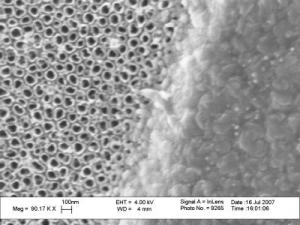Scientists are working to build more stretchable and efficient prosthetics for soldiers with missing arms or legs. Even after fixing new prosthetics, bacteria give trouble by entering through space in the implanted area. So, there is necessity to close the skin where bacteria enter.
Webster and Brown University researchers have possibly found ways to prevent bacterial migrants. This team found two new ways to promote growth of skin during implantation; one is to modify the titanium leg implants surface to close the skin gap and another is to create a molecular chain to spray skin-growing proteins on the implant.
 Anodizing the titanium surface of a surgical implant, left, yields a roughened surface of nanotubes, which skin cells colonize more quickly.
Anodizing the titanium surface of a surgical implant, left, yields a roughened surface of nanotubes, which skin cells colonize more quickly.
The researchers, Melanie Zile, a Boston University student and Sabrina Puckett, an engineering doctorate have developed two dissimilar nanoscale surfaces.
Initially, researchers excited an electron beam of titanium coating at the implanted piece, which is inserted into the bone and produced 20 nm mounds. These mounds replicate the natural skin shape and promote growth of additional keratinocytes. Usually, this method is used for re-growing bone and cartilage cells.
Next is the anodization method, in which the abutment is dipped into hydrofluoric acid and given electric current. This makes titanium atoms to reassemble to form tubular structure on the abutment's surface and nanomounds help for this reassembly by doubling the thickness.
Webster researchers identify FGF-2, a protein secreted by the skin to promote growth of the skin around the implant. By just covering FGF-2 protein on the abutment will be less effective, so the researchers use a synthetic molecular chain to unite FGF-2 to the titanium surface in order to advance skin growth. Additionally, the nanomodified surfaces make more surface area for FGF-2 proteins for traditional implants.
Source: http://www.brown.edu/